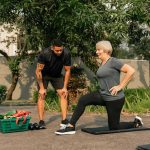It’s a hard time to get moving in the winter months. The days get shorter, the temperature drops, and snuggling up inside is often easier than going for a workout. But staying healthy during the winter is vital not only for your health but also for your mental state. If you’re wondering how to stay on track with your workouts during colder weather, here are some tried-and-true tips for getting the most out of winter workouts.
Enjoy the Great Outdoors with the Right Equipment
The cold may be the hardest hurdle, but if you dress appropriately and work with the proper technique, outdoor exercise is not only cool, it’s fun. Layers are key here.
Layer Up Wisely:
Layering is recommended to begin with a moisture-wicking layer to eliminate sweat. This will also keep you dry and keep you warm.
Next, put on an insulating layer such as a fleece or lightweight jacket. It will absorb your body heat and will not make you feel cumbersome.
Layer: The last and final thing is a water- and wind-proof layer if you’re working out when it’s windy or raining. It’ll protect you from the elements without feeling bulky.
Accessories: Remember the hat, gloves and socks. Your head, hands and feet carry heat away first, so keeping them warm will be necessary for your comfort. Touch screen gloves can come in handy when you’re running on a fitness tracker or want to rotate playlists mid-run.
Winter Shoes: If you’re running or hiking in the snow, get grippy shoes or winter trainers. Some companies provide shoes with enhanced traction or slip prevention inserts.
Shift to Indoor Workouts
If you are scared of going outside in the cold, indoor exercises are an excellent substitute. Even with a healthy indoor routine, you can stay or get in shape.
Workouts At Home: From bodyweight circuits to yoga flows, there’s no end to the types of workouts you can squeeze in your living room. You can incorporate lunges, push-ups, burpees and planks into a circuit for an all-over body workout. Resistance bands and dumbbells can provide an added challenge if you have them on hand.
Online Classes and Apps: Now that virtual training is on the rise, there aren’t too many online classes or apps for you to exercise with. Look into apps or Youtube channels that provide guided workouts that work for your goals, be it strength, cardio, yoga or something else. You can choose a routine that fits your time and space.
Neighbourhood Gyms and Studios: It is best to visit your neighbourhood gyms or a local fitness studio during the winter months. The majority of gyms offer trial passes or discounts during the winter, making staying fit affordable. Check out group classes if you need a little bit of social validation—social support is what keeps you going when it’s grey and chilly outside.
Try Winter-Specific Sports
If you’re ready to maximise the season, why not take up a winter sport? They aren’t just great for the body, but they also make winter a little more exciting.
Ice Skating: Great for core strength, balance, and endurance. Seasonal ice rinks are plentiful in most towns and cities, so take a look at the local options. And it’s an entertaining, communal activity for friends or family.
Skiing or Snowboarding: If you live near a ski resort or even an artificial one, skiing and snowboarding are great all-body exercises that focus on your legs, core, and balance. They’re gruelling exercises, but the fun factor takes all the pressure off you.
Winter Hiking: Winter hikes are not only beautiful, but also a great way to pump up your heart rate while taking in nature. Track down trails that are still open for the winter and be sure to protect yourself — wear proper shoes and double-check the weather before you head out.
Adapt Your Work Outs to Winter Conditions
You have to warm up a little more for your winter exercises. Cold muscles are easily injured, so give yourself a few extra minutes to get your body moving and your blood flowing.
Extended Warm-Ups: Warm up in the house with a few easy indoor exercises before going outside such as jumping jacks, squats, or even jogging up and down the stairs. This warms your core and primes your muscles for action.
Take it Easy: If you’re running or doing cardio outdoors, warm up at a slower speed and gradually increase the speed. This gives your body time to get used to the cool air and minimises strains.
Keeping Your Motivation High
It’s not the cold that gets you in winter, it’s being motivated. You struggle to get motivated to exercise on the colder, darker days, so motivation is the key.
Goals for the Winter: With a goal you know what you’re working toward. It might be a mile or a pound you’ll be able to lift by springtime. This keeps you on track by setting achievable, feasible targets.
Get a Workout Buddy: There’s nothing like having a friend or workout partner to cheer you on. You’re more likely to stick with your training plan when you have someone to train with, and you’re less likely to skip out on a workout when you have someone to work with.
Make A Treat of It: Create small treats to remind yourself to continue with your winter workouts, such as a hot bath or a meal after a particularly hard session. Small rewards are worth it when you’re dealing with winter depression.
Listen to Your Body
The cold is physically draining, so make sure you listen to your body. The colds are worse in the winter and if you are running low, you can always take a day off or do something lighter, such as yoga or stretching.
Hydration Is Essential: You sweat when you work out even when it’s cold outside. Drink plenty of water because dehydration sneaks up on you in winter as much as during summer. Get a glass of water during your workout and drink it throughout the day.
Keep Your Lungs Healthy: Cold weather is not good for your lungs, particularly during intense outdoor activities. If you’re a heavy breather, keep a scarf or neck warmer over your mouth to warm the air before it reaches your lungs.
Enjoy the Advantages of Cold Weather Exercises
Not sure you’d believe this, but there are perks to exercising in the colder months. For one, your body might have to work a little bit harder to stay warm, and you’ll burn more calories in cold-weather workouts. Additionally, winter workouts will make you happier and will help fight off winter blues. Natural light, even on a grey day, balances your circadian rhythms, improving your sleep and mood.
Winter doesn’t have to be hibernation for your fitness. You can stay on pace, or even keep up with your fitness, as long as you make the right changes and apply the right tactics in the winter months. Whether you are packing to run outside, trying something new in the comfort of your own home, or trying out a winter sport, there are multiple opportunities to get fit. So embrace it, and soon you will have a tiger in spring.

Creating Healthy Goals: A Formula for Long-Term Success
We’ve all heard the adage that goal-setting is a powerful motivation to stay motivated with exercise, but seriously, how many of us have achieved big, shiny goals in January and been left flat out in March? The secret to lasting change is not big goals but small, attainable steps towards real, lasting change. What follows is a guide to setting fitness goals that will keep you excited, committed, and most importantly, successful.
- Start with Your “Why”
Before you embark on fitness, take a step back and figure out why you want to change. Would you like to be healthier, less stressed, stronger, or just more comfortable in your own skin? By knowing your “why” you can make more real goals rather than fake ones.
If, for instance, you primarily want to be more active, you can make resolutions about exercising regularly and eating well. Exercise and mindfulness training, combined, may be a better way to stay mentally healthier. Knowing why helps you establish realistic goals.
- Set SMART Goals
The SMART strategy (Specific, Measurable, Achievable, Relevant, and Time-bound) is a time-tested formula for goal-setter success. It can break your big dreams into smaller objectives so that you can see how far you’ve come and if you’re on track.
Here’s how it works:
Concise: Try to make it as explicit as possible. Rather than saying, “I want to get fitter,” simply say, “I want to increase my running endurance so that I can run 5km without stopping”.
Measurable: Select objectives that you can monitor. This could be lifting a specific amount of weight, getting rid of a particular number of inches, or exercising a certain number of days a week.
Achievable: Create goals that are difficult, but do not take a lot of effort to accomplish. You might not be able to run two marathons in two months if you’re new to running, but you may be able to run a 5km in three months.
Relevant: Make sure the objective reflects your lifestyle and future aspirations. Think about whether or not this is actually your “why” and a way to live your life.
Date-bound: Provide a date by which you can track your progress. Minimalistic deadlines (weekly or monthly) keep you accountable.
- Restructure Your Objectives into Steps.
It’s great to have an ambitious goal, but without the smaller checkpoints, it might feel like a hard walk there. Convert your primary objective into milestones that allow you to feel a sense of accomplishment in the process.
If, for instance, you want to lose 10kg, then reduce it to 1-2kg per month. These little achievements help you see a road map and keep you motivated from time to time. This helps you make the process more accessible and keep your mind geared toward what you are trying to do now, rather than becoming enamoured with the outcome.
- Set A Process, Not An Endpoint.
When people set fitness goals, one of the biggest mistakes they make is just achieving the end result without setting a routine. Habits are the pathway to long-term change, so consider what will get you there and how you can put it into your life.
For example, if you want to become stronger, schedule certain strength-training days each week, even if they’re just 20 minutes. Small steady doses are more effective than frequent big sessions. Ensure that you incorporate these practices into your week so fitness is not something you need to reach for, but something you do.
- Track Your Progress
Progress is what keeps you motivated and allows you to adapt as needed. Be it in a journal, app, or even a simple spreadsheet, tracking your workouts, weight loss, or measurements provides you with physical proof that you are getting better.
You might want to increase flexibility, for instance, and see how far you can get on specific poses each week. If you want to improve endurance, measure how far you can run or cycle before you stop and congratulate yourself for small gains.
Every day of seeing how far you’ve come makes you feel more encouraged to continue.
- Adjust as You Go
When working toward a long-term vision, be flexible. Life happens — accidents, children or work commitments can all take a toll on your training. Rather than give up at the first hurdle, be prepared to rethink your targets when necessary. This can include extending your timeline or altering your workouts.
For example, you decide to exercise five days a week, but it’s busier than you expected. Don’t feel guilty or disillusioned, reduce the number to three days per week until you get comfortable. As always, a little is better than nothing, and flexibility gets you moving forward.
- Celebrate Small Wins
Do not wait until you hit your goal to congratulate yourself. Each step you take is a worthy one, and small successes inspire you and make it feel like you’re on your way.
Small victories may range from pushing a bit more weight, running a little faster, sticking to a routine for a month, or just feeling more energetic during the day. Such achievements deserve to be celebrated because they are the building blocks of sustained success.
Reward yourself with something meaningful. It might be a new piece of gym equipment, a massage, or a weekend getaway. Recognizing small successes builds habits and keeps you motivated about the journey.
- Stay Patient and Consistent
For lasting change to occur, we have to be patient and steadfast. You want it immediately, but lasting change takes time. If it’s slow, keep reminding yourself that monthly or yearly repetition will benefit you more than any “one-off”.
Fitness isn’t about being perfect — it’s about going, even when it hurts. By being patient and consistent, you’re creating a lifestyle that aligns with your vision, rather than an item on a list.
- Reflect and Set New Goals
When you do achieve something, step back and reflect on your accomplishment. What worked well? What challenges did you overcome? Knowing what you have accomplished, and the challenges you’ve overcome, enables you to identify your own resilience and capabilities.
If you’re feeling refreshed, create new objectives to keep the fitness routine new. Now that you’ve crossed the weight loss goal, perhaps now you want to focus on strength or flexibility. So you’ve run 5km, so maybe 10km is the next step. Fitness is not an endpoint, so don’t stop pushing yourself and striving for new things that thrill you.
Final Thoughts
To set sustainable fitness targets is not just to have something to strive for but to map out a path to success. If you can set goals that are in line with your values, break it down into smaller increments, and develop routines that you can stick to, you will make your workouts sustainable.
Remember, things will get better over time, and every bit of progress counts. Stay the course, take it slow and appreciate every bit of progress. By doing it right, you’ll be becoming a more powerful, healthier, and more positive version of yourself, and this is way beyond any short-term purpose.
Carl is a fitness trainer based in Newcastle upon Tyne UK.


